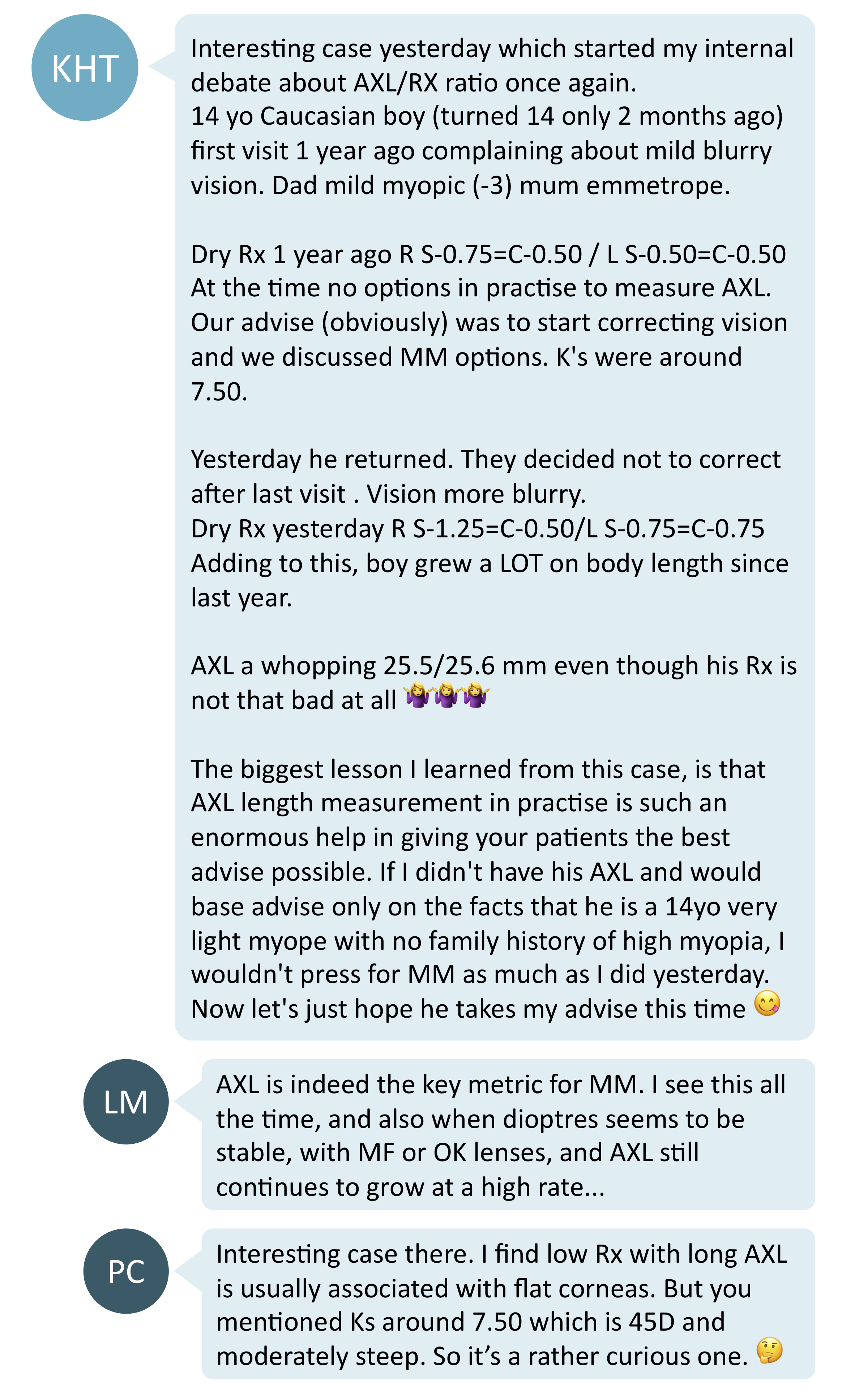Axial length and refractive error are typically correlated. This interesting post discusses a case where there is a mismatch between axial length (AXL) and refractive error whereby the patient with low myopia had unexpectedly high axial length.

Why axial length matters in this case
Measurement of axial length is a gold standard for a research study investigating myopia control interventions, but is not routinely measured in clinical practice. Given that refraction is always measured in clinical practice, it has traditionally been used as the marker for myopia pathology risk. Historically, low and moderate myopia up to 5-6D was termed 'physiological' but the International Myopia Institute Defining and Classifying Myopia Paper (link) did away with this erroneous terminology. We now understand that any level of myopia increases risk of pathology compared to emmetropia - there is nothing 'physiological' or 'normal' about this increased risk.1
We understand that axial length is a useful disease risk indicator for adult myopes, and a useful indicator for urgency of a myopia control strategy in kids, with 26mm being the apparent delineation from the literature.
This child's axial length is already very close to this 'line in the sand' for where the lifelong risk of vision impairment jumps from around 3% for eyes 24mm to less than 26mm long, to around 25% for eyes 26mm to less than 30mm long.2
Axial length correlation to refractive error
Typically a longer eye is more myopic, but this is not always the case as shown here. Rozema et al3 found that in Singaporean children, myopia onset occurred at 24.08±0.67mm in boys and 23.69±0.69mm in girls. The three-year MiSight study found a ratio of 1mm axial to 2.40D refractive change in their treatment and control groups.4 It’s spurious to merge these studies given variable ethnicities but for the sake of demonstration, we might expect eyes of 25.5mm axial length, as in this case, to equate to around -3.25-3.50D, rather than the -1.25-1.50D best spheres described. In such cases, the crystalline lens power may play a larger role in masking axial elongation from having a greater influence on refraction.4
Corneal radius and refractive error
From the research, the relationship between corneal radius and refractive error is varied. Myopes generally have steeper corneas than emmetropes,.7,8 although corneal power doesn’t seem to alter much after onset of myopia in children.5 Research has also shown that the contribution of corneal power to total eye power reduces with longer axial lengths.9
Body height and axial length
The original poster KHT also mention that the patient had grown much taller in the last year. Research has shown that body growth and axial length are correlated.10 Besides, myope has greater axial elongation than emmetrope. For persistent emmetropes, a 1cm increase in body height was correlated with a 0.03mm increase in axial length. For persistent myopes, every 1cm increase in body height was correlated with a 0.15mm increase in axial length. It is logical that a myope would exhibit greater increase in axial length compared to an emmetrope, though, due to myopia progression.
Due to this relationship between axial length and body height, it's worth keeping in mind that the peak height velocity (PHV) - the fastest annual rate of height change - was shown in an American study of primarily white children to be 12.1 years for girls and 13.7 years for boys.11
Take home messages:
- Axial length measurement is a very useful metric for assessing disease risk, and potentially casts a different light on management of the long-eyeballed low myope.
- An axial length of 26mm or greater appears to be a key delineator for lifelong risk of vision impairment due to myopia-associated pathology.
- If axial length measuring equipment is not available in your practice, you can consider co-managing with a local optometrist colleague or ophthalmologist with the required equipment.

About Connie
Connie Gan is a clinical optometrist from Kedah, Malaysia, who provides comprehensive vision care for children and runs the myopia management service in her clinical practice.

About Kimberley
Kimberley Ngu is a clinical optometrist from Perth, Australia, with experience in patient education programs, having practiced in both Australia and Singapore.
This content is brought to you thanks to an unrestricted educational grant from

References
- Flitcroft DI. The complex interactions of retinal, optical and environmental factors in myopia aetiology. Prog Retin Eye Res. 2012;31:622-660. (link)
- Tideman JW, Snabel MC, Tedja MS et al. Association of Axial Length With Risk of Uncorrectable Visual Impairment for Europeans With Myopia. JAMA Ophthalmol. 2016;134:1355-63. (link)
- Rozema J, Dankert S, Iribarren R, Lanca C, Saw SM; Axial Growth and Lens Power Loss at Myopia Onset in Singaporean Children. Invest Ophthalmol Vis Sci 2019;60:3091-3099. (link)
- Chamberlain P, Peixoto-de-Matos SC, Logan NS, Ngo C, Jones D, Young G. A 3-year randomized clinical trial of MiSight lenses for myopia control. Optom Vis Sci. 2019;96:556-567. (link)
- Mutti DO, Mitchell GL, Sinnott LT, et al. Corneal and crystalline lens dimensions before and after myopia onset. Optom Vis Sci. 2012;89(3):251-262. (link)
- Goss DA, Van HV, Rainey BB, Feng B. Ocular components measured by keratometry, phakometry, and ultrasonography in emmetropic and myopic optometry students. Optom Vis Sci 1997 Jul;74(7):489-95. (link)
- Grosvenor T, Goss DA. Role of the cornea in emmetropia and myopia. Optom Vis Sci. 1998 Feb;75(2):132-45. (link)
- Blanco FG, Fernandez JC, Sanz MA. Axial length, corneal radius, and age of myopia onset. Optom Vis Sci. 2008 Feb 1;85(2):89-96. (link)
- Kearney S, Strang NC, Cagnolati B, Gray LS. Change in body height, axial length and refractive status over a four-year period in caucasian children and young adults. Journal of Optometry. 2020 Jan 25. (link)
- Granados A, Gebremariam A, Lee JM. Relationship between timing of peak height velocity and pubertal staging in boys and girls. Journal of clinical research in pediatric endocrinology. 2015 Sep;7(3):235. (link)











